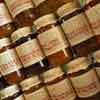OUR Product
PRODUCT LIST | QUALITY INGREDIENTS
quality ingredients
All Eswatini products are 100% natural with no artificial colours, flavours or preservatives.
If you’d like more information or recipes about the various fruits used in Eswatini’s products, we’d be happy to supply you. Email your request to sales@eswatinikitchen.co.sz
MARULA
The ripe marula is a small yellow fruit roughly the size of a golf ball. The pulp (used for the jam) surrounds a single seed. It is harvested from the wild and brought to Eswatini Kitchen to be peeled by the women, ready for cooking. This fruit is then processed in our factory to make the richly flavoured marula jam.
Marula fruit has four times the Vitamin C of orange juice and is high in potassium, calcium and magnesium. Marula fruit pulp analysis shows vitamin C content as 54mg per 100g. Local Swazi communities have used the goodness of the marula fruit for generations as an important nutritional addition to their diet.
Marula fruit could be described as a sweet, refreshing taste with a slightly tart edge – embodying the richly delicious and earthy flavours associated with tropical fruits.
MANGO
Mango is one of the well known exotic species of the tropics. It can be used in sweet and savoury recipes, salads and desserts. It has a rich, creamy flavour equally delicious as a sumptuous jam or base for spicy chutney. Swaziland has the ideal climate to produce this succulent fruit, which thrives best in an average maximum temperature between 27 and 36 ˚C. The mature mango tree is a beautiful large evergreen which produces a roughly oval shaped fruit with thin skin and deep yellow flesh surrounding a large fibrous seed. Different varieties of mango can differ in colour and size. An average fruit is as large as an adult’s hand.
GUAVA
Guava is a member of the myrtle family Myrtaceae. The small yellow fruit are entirely edible. Guava trees are abundant in Swaziland and are said to fruit best in areas with a distinct winter season making it ideal for Swaziland’s climate with a mild cool period from about May to September.
RUBY GRAPEFRUIT
The fruit of the Ruby Grapefruit is distinctive, as the name suggests, for its jewel-like colour. A luminescent hue which can range in different varieties from deep red to delicate pink and coral shades. It is a sweeter fruit than its yellow cousin, ideal for a beautifully distinctive marmalade in its own right.
PINEAPPLE
The pineapple is a tropical or near-tropical plant, but will tolerate quite a variety of temperature and rainfall conditions. They are drought-tolerant and can even be grown in a container for an interesting potted plant. The plant is a herbaceous perennial, 2 to 5 ft. high with a spread of 3 to 4 ft. It is a short, stout tuft of waxy, straplike leaves with sharp spines on the edges developing in a rosette formation. Many people assume pineapples grow on trees and are surprised to see their first pineapple plant with fruit growing from a cactus-like clump of foliage on the ground.
The oval compound fruit develops from many small fruits fused together commonly growing as large as dinner plate. When ripe it has a sweet, juicy, fleshy pulp with the stem forming a fibrous core down the centre of the fruit. The outer skin may be dark green, yellow, orange-yellow or reddish when the fruit is ready to eat.
SISAL
Sisal grows as a cactus and is harvested from the leaves which are cut and stripped. The resulting fibrous material is scraped with a stone to remove the wet pulp leaving a long thread, the consistency of tough cotton. It is washed and dried, then dyed ready to be spun into the thread which is then wrapped around grass stems. A group of women prepare the sisal for the basket weavers – again providing employment through Eswatini’s products.
|




